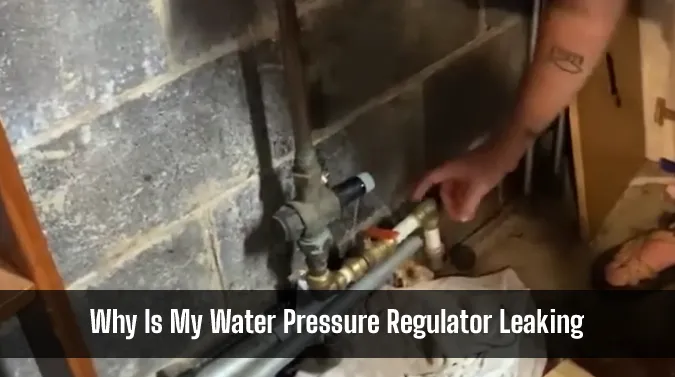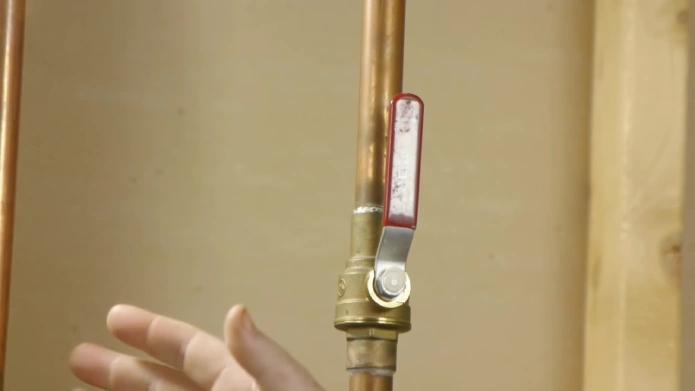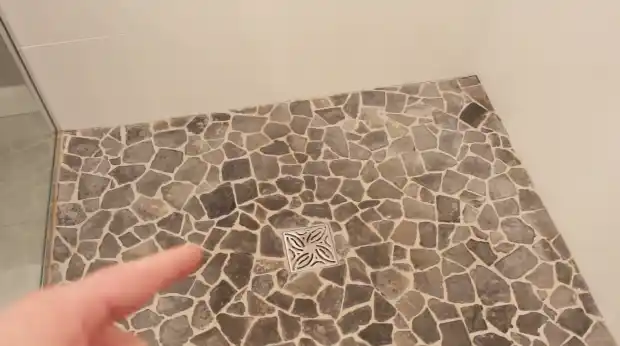Last Updated on May 2, 2023
Have you suddenly started noticing mysterious water puddles in your house? Chances are that the problem lies with a faulty water pressure regulator, an issue many homeowners nationwide struggle with. Acting quickly is key. These leaks can cause more damage if not fixed fast enough.
A water pressure regulator is a vital component in most modern homes that helps maintain the balance of water pressure entering your home. Sadly, like any other plumbing device, it can develop problems over time. Often, it’s the cause behind unexpected plumbing issues that leave you scrambling to find a solution.
Although other issues like deteriorating gaskets, wear and tear, or even manufacturer defects can cause your water pressure regulator to leak.
Let’s get to the bottom of what’s causing the problem, plus how to spot and fix it.
Why Is My Water Pressure Regulator Leaking: Some Common Causes

Protecting your plumbing system is as easy as installing a pressure regulator. This simple device can help secure pipes, appliances and fixtures from the damaging power of over-pressurized water.
Here’s why water pressure regulators leak:
Deteriorated Gaskets
Gaskets in a water pressure regulator helps to create a tight seal and prevent leaks. Over time, these rubber or plastic components can deteriorate due to constant exposure to water, temperature fluctuations, and other external elements.
A deteriorated gasket compromises its sealing capability, leading to leaks in the water pressure regulator. Regular inspection and timely replacement of worn-out gaskets can prevent this issue and keep the regulator functioning optimally.
Wear and Tear
Water pressure regulators are subjected to continuous wear and tear to control the water flow and pressure of the valve. Prolonged usage can lead to internal components, such as springs or diaphragms, becoming worn or damaged.
This can result in reduced functionality, and leaks may occur. Maintaining your water pressure regulator and replacing worn-out parts can prevent leaks and prolong their life.
High Water Pressure

A water pressure regulator regulates the water pressure released from the valve under specific pressure limits. If the incoming water pressure is consistently above the maximum capacity of the regulator, it can cause strain on the internal components or the housing, leading to leaks.
Scheduling regular checks on the incoming water pressure and ensuring that it matches the pressure regulator valve’s recommended range can help prevent leaks caused by high pressure.
Improper Installation
Leaks in a water pressure regulator can also result from improper installation. Incorrectly installed regulators may lead to misaligned parts, poor seals, or uneven weight distribution, causing water to escape through the gaps or seams.
It is crucial to follow the manufacturer’s installation guidelines and consult a professional plumber to ensure proper and leak-free installation.
Debris or Sediment Buildup
Debris, sediment, or minerals present in the water can accumulate inside the water pressure regulator, resulting in reduced performance, clogs, and, consequently, leaks.
Regulators and water pressure valves must be cleaned and inspected regularly to prevent leaks, eliminate accumulated sediment, and keep them working.
Water Hammer
A water hammer is a sudden increase in water pressure caused by the abrupt stoppage of water flow. This sudden surge in pressure can damage the water pressure regulator’s internal components or housing, leading to leaks.
Installing water hammer arrestors or shock absorbers in the plumbing system can help mitigate the risk of water hammer-related leaks in the regulator.
Corrosion
Corrosion can be a major cause of leaks in water pressure regulators. Persistent exposure to water, minerals, and air can result in the formation of rust, causing the weakening or damage of the regulator’s housing or internal components.
Regular inspection for signs of corrosion, coupled with proper maintenance, can help prolong the regulator’s life and prevent leaks.
Manufacturer Defects
Sometimes, a leaking water pressure regulator may be attributed to manufacturing defects. These defects could include flawed design, inferior materials, or poor quality control during production.
Choosing a reputable brand and ensuring the regulator comes with a warranty to safeguard against potential defects is crucial.
What Are Some Signs That The Water Pressure Regulator Is Leaking?

Did you know that paying attention to your water pressure regulator can save you from expensive repairs? If strange sounds or mysterious water stains have been spotted, it’s time to closely inspect the trusty regulator.
Here are seven clever ways to recognize when your unit needs special care:
Inconsistent Water Flow
A key indicator that something is wrong with the water pressure regulator is inconsistent water flow from your faucets. Water should flow out steadily, so it might be time to check your regulator to see if it’s suddenly coming out in a weak, slow trickle or a forceful gush.
Fluctuations in water flow can be disruptive and sometimes damaging, especially if they’re happening in your dishwasher, washing machine, or other appliances.
High or Low Water Pressure from the Faucet
If you’re experiencing unusually high or low water pressure in your home, it could be due to a malfunctioning water pressure regulator. A properly functioning regulator maintains a consistent water flow throughout your plumbing system.
However, if it’s leaking, you’ll notice these pressure inconsistencies that could harm your pipes, appliances, and fixtures.
Vibrating or Banging Pipes
One common symptom of a faulty water pressure regulator is the unnerving sound of vibrating or banging pipes. This noise often called a “water hammer,” can occur when the regulator fails to control the water pressure and water rushes through the plumbing too quickly.
Not only is this sound irritating, but it could damage your pipes in the long run.
Water Pressure Gauge Reading Higher than Normal

Homeowners should periodically check the water pressure gauge to ensure the proper functioning of their water pressure regulator. If the reading is consistently above 75 to 80 PSI, it could indicate that the regulator is not doing its job and might be leaking.
Water Stains
Water stains on walls, ceilings, or cabinetry are often the first visible signs of a water leak. If you notice these unsightly stains near your water pressure regulator, it’s time to call a plumber or take the necessary steps to assess the situation.
Visible Leaks near the Regulator
If you see water seeping or dripping around your pressure regulator, it clearly indicates something is amiss. While this might seem obvious, regular inspections can help you detect the problem early on so you can address it before it causes extensive damage to your home.
Higher than Usual Water Bills:
A sudden spike in your water bill could be a sneaky sign that your water pressure regulator is leaking. A malfunctioning regulator can lead to water waste and increased consumption which, in turn, will inflate your water bill.
Keep an eye on your utility bills and promptly address any suspicious increases to avoid water damage and save money in the long run.
How Can You Troubleshoot a Leaking Water Pressure Regulator?
So we know there are telltale signs that your water pressure regulator could be leaking, but don’t let it cause a splash. Knowing what to look for and how to take action can help protect against costly repairs.
If you suspect your unit is malfunctioning, here are some simple steps to take:
Identify the Source of the Leak

Begin by thoroughly examining the water pressure regulator and surrounding pipes to determine the exact source of the leak. Ensure that you check all connection points, looseness of hardware, and signs of corrosion on the pipes as well.
Identifying the source of the leak will allow you to focus your troubleshooting efforts on the root cause and avoid unnecessary interventions.
Check the Pressure Setting
The right pressure setting is key to your water pressure regulator working right. Refer to your regulator’s manual or consult your plumber to determine the ideal pressure setting for your home.
Adjust the pressure setting as needed, ensuring that it’s not too high, as this can lead to leakage issues. Remember to track the regulator’s performance post-adjustment to confirm the leak’s resolution.
Inspect the Regulator Diaphragm
The rubber diaphragm within the regulator may wear out over time and cause leaks. To inspect the diaphragm, first shut off your water supply and remove the regulator. Carefully examine the diaphragm for any signs of wear, tear, holes, or brittleness.
If you notice any damage, replace the faulty diaphragm with a new one before reinstating the regulator and water supply.
Clean the Regulator
Debris and dirt buildup inside the water pressure regulator can obstruct its internal mechanisms, leading to leaks. To clean the regulator, disconnect the water supply and carefully disassemble the device.
Gently clean the internal components with a soft brush or cloth, ensuring that you remove any accumulated dirt or debris. After cleaning, reassemble the regulator and gradually restore the water supply to confirm if the leak has been resolved.
Replace the regulator
If none of the above troubleshooting steps yield any positive results, replacing the entire water pressure regulator may be necessary. Consult a qualified plumber for guidance on selecting the appropriate regulator model that matches your home’s requirements.
Once the new regulator is installed, monitor its performance closely to verify if the leaking issue has been resolved.
How Often Does a Water Pressure Regulator Leak?

A pressure regulator should ideally not leak regularly. It is designed to open only when the pressure inside the system exceeds the set limit, allowing excess pressure to be released and ensuring safety.
Consequently, occasional leakage may occur when the valve is functioning to regulate pressure during exceptional circumstances. However, frequent or excessive leakage can indicate a faulty valve or issues within the system.
In such cases, promptly inspecting and addressing the underlying problem is essential to prevent system failure or potential hazards.
Unchecked Water Pressure Regulator: The Silent Enemy of Home Maintenance
A leaking water pressure regulator can cause a range of inconveniences and potentially costly damages to your home. Understanding the common causes, like deteriorated gaskets, high water pressure, or improper installation will help you easily pinpoint and address the issue.
Keep an eye out for tell-tale signs of a leak. And if you spot one, take prompt action to troubleshoot and remedy the problem. Remember, too, that regular maintenance of your water pressure regulator is crucial in preventing leaks and prolonging the lifespan of your plumbing system.
Follow these tips to ensure your water pressure regulator works well and is leak-free. You’re better off calling a pro if you can’t fix it yourself.



